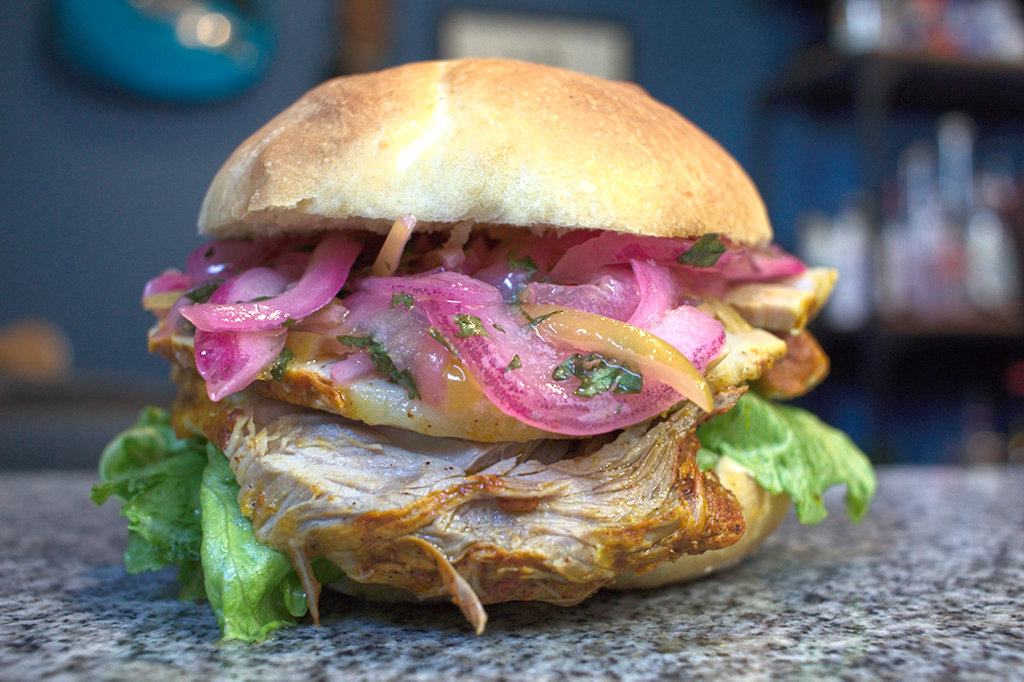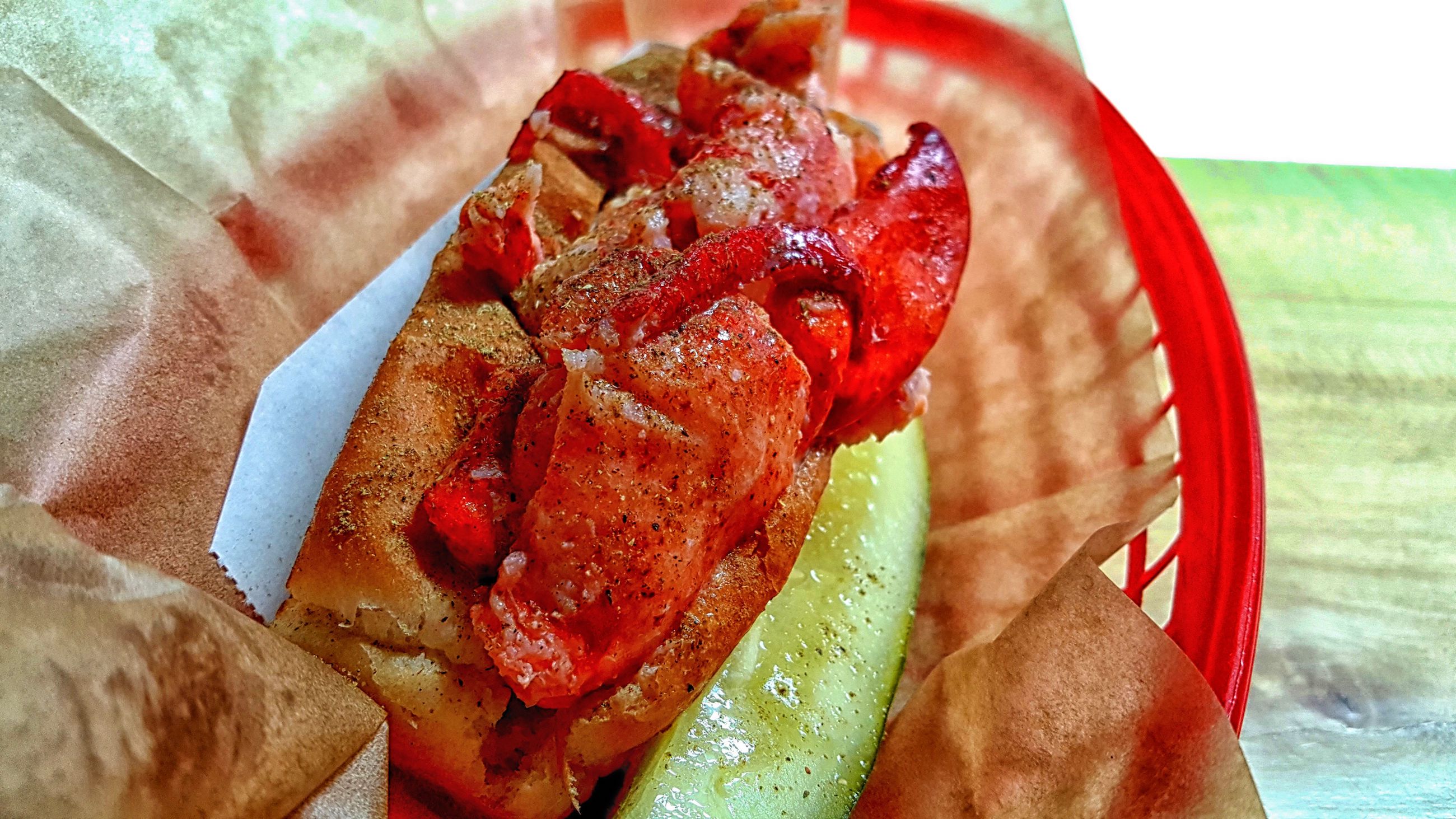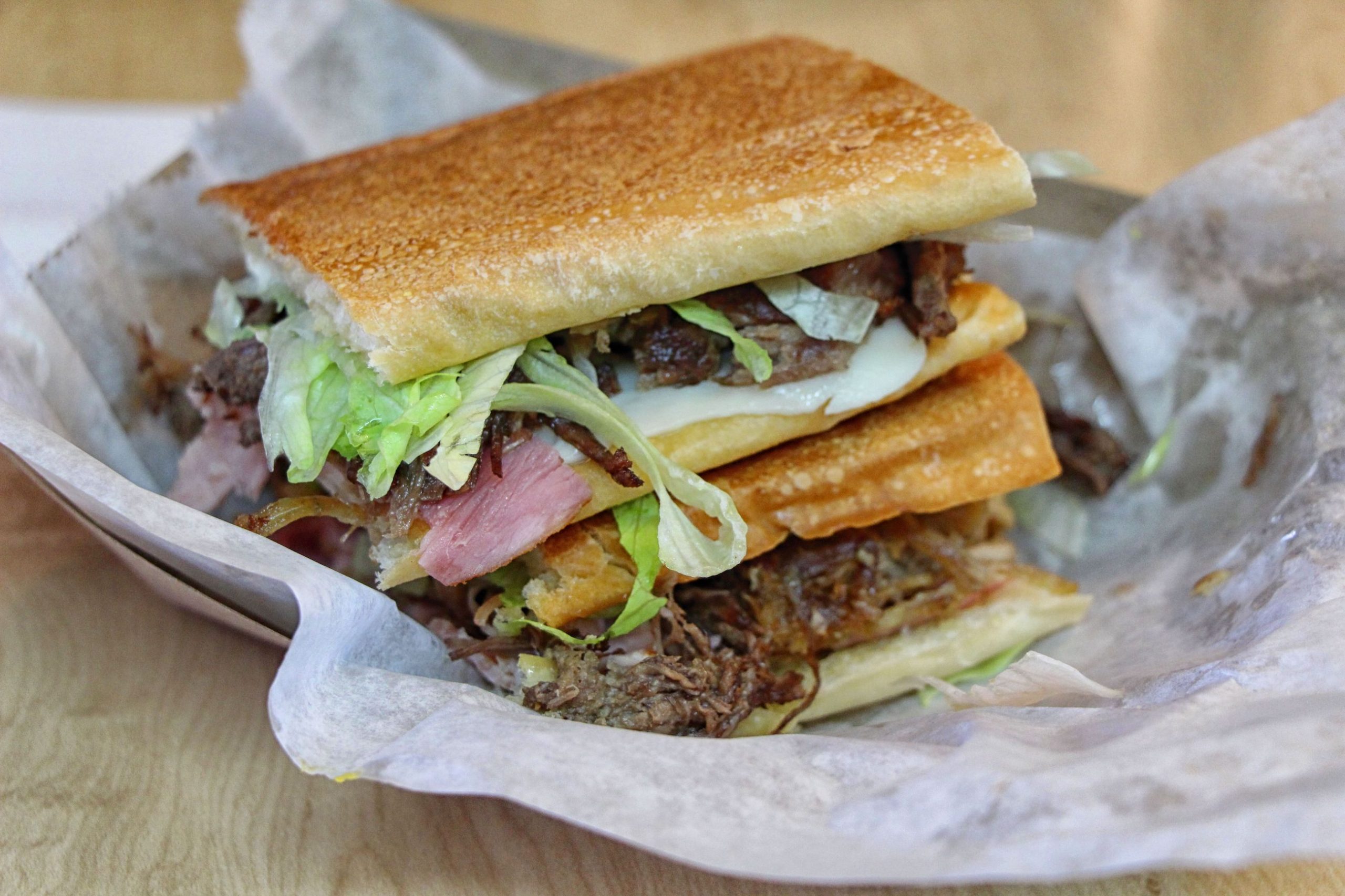Peruvian Butifarra
Botifarra is the name of a sausage that is central to the cuisine of Catalonia, a region of northeastern Spain. The word “botifarra” itself is from the Catalan language, derived from bot, a word that like much of the Catalan language comes from the vulgar Latin, in this case meaning a cask or wineskin. There are multiple versions of the Catalan sausage, and the word has made its way into the Spanish of many South American countries, usually in the form butifarra and almost invariably as a local type of sausage.

Only in Peru does butifarra mean something different. The Peruvian butifarra is a type of sandwich, a section of baguette or a type of bread roll called pan frances (French bread) stuffed with jamon del pais (country ham) and salsa criolla (Creole sauce), with lettuce and mustard or mayonnaise or other condiments.
When I first heard about this sandwich a year ago, a friend on Twitter let me know that the Peruvian restaurant SanguCHE in nearby Naperville served a worthy version of this sandwich. I was looking forward to making my way there this month and trying it. Unfortunately, when I checked their menu earlier this month, I found this notice:
Due to COVID-19, we are having to TEMPORARILY LIMIT OUR MENU to the following sandwiches. We apologize and thanks for your patience as we expand our menu when more ingredients become available.
Damn you, coronavirus! Once again you have laid waste to my sandwich plans. I suppose I’ll just have to make it myself.
Jamon del pais
Jamon del pais translates as “country ham,” but that name in this case is a bit of a misnomer. Jamon del pais is not a cured product. Traditionally made from a deboned, butterflied pig leg, but commonly made from pork loin these days, it is brined for a brief time, a few hours or overnight, in what is quite a weak brining solution. The recipe I used called for 1 tbsp of salt per 2 liters of water. I used Morton’s kosher salt, which is denser than some other types of salt and works out to 18 grams per tablespoon. According to this table, that comes to a brining solution of less than 10 degrees, when the recommended brining strength is 70-80 degrees. I’m not sure what this step is meant to accomplish but I soaked the meat overnight in slightly salty water as instructed.
Once the brine is complete, the pork–in my case, I deboned, butterflied, and removed the skin from a picnic ham (not skillfully, but moderately successfully) then pounded it out as flat and square as I could–is dried off then slathered in a paste consisting of annatto, garlic, cumin, chilis, black pepper, oregano, and salt, and allowed to marinate for an hour or more before being rolled tightly and tied up with twine then simmered for 90 minutes in water with aromatic ingredients like onions and carrots and herbs.

The resulting hunk of meat is a pale orangish-yellow in color and not much reminiscent of ham at all. It is then brushed with olive oil infused with the flavor and color of annatto seeds to reinforce the orange color.

Jamon del pais 
Annatto oil 
Jamon del pais
I found that at least my jamon del pais would need, at this point, to be allowed to cool off before removing the twine and slicing it, lest it try to revert to its former flat shape. So I wrapped it in plastic and rested it overnight before starting in on the sandwiches.
Pan Frances

As mentioned, the bread for this sandwich can be a baguette or a French roll, but since I was going to the trouble of creating the jamon del pais, why not create a more authentic bread roll, the Peruvian-style Pan Francés. Besides, they look delicious!
So I looked around for a recipe that looked right. Authentic food may be “bullshit” but if I’m trying to recreate a Peruvian bread roll, I’m probably going to look for a recipe that’s in Spanish. And I found plenty, but the first Google result in this particular instance ticked a few important boxes for me when I’m looking for a bread recipe. Measurements in grams? check. Overnight preferment? check. A Peruvian recipe published by… *checks notes* a Ukrainian living in Spain? Ok so it wasn’t perfect, but the rolls looked tasty. And they turned out nice too!

The one thing that was unfortunate about these rolls was the size. The recipe said that a proper weight for each roll was about 40 grams, even though she made hers 60 grams each. I did some quick math, and with a total dough weight of 780ish grams, that meant if I just split the dough into 16 even pieces, they’d each be between 45 and 50 grams. Perfect, right?
Only the 45-50 gram rolls were somewhat small, about 2.5 to 3 inches in diameter, and the deboned leg of pork was quite large, maybe 6 inches in diameter. That would create an intolerable overhang situation. I’d have to cut up each individual slice of jamon del pais into multiple pieces and stack them to make my sandwiches. Not ideal, but I plowed ahead.
Salsa Criolla
The other required ingredient for the Butifarra is salsa criolla. Now I’ve made Argentine salsa criolla for the site before, but the Peruvian version is different, consisting mainly of red onion with some Aji Amarillo, a chili pepper omnipresent in Peru, and frequently used in their cuisine, cilantro and lime juice. The recipe I used is from the same page as the jamon del pais recipe linked above–the other recipes I found left out the chilies, or added tomatoes, or replaced some or all of the lime juice with vinegar.

There may be sources for fresh aji amarillo here in the Chicago area of which I’m unaware, but all I was able to find were 2 things. First was a jar of aji amarillo paste, a brand from Peru, that I used in the marinade for the jamon del pais. That wasn’t going to work in this salsa though, which called for long strips of chili rather than a spicy mush. Second was a jar of La Preferida brand Whole Yellow Chilies. Are these the same thing? They are not. They are cascabel peppers, which is an entirely different species of chili. They have a little heat, about the same or possibly slightly milder than a pickled jalapeno, so the salsa criolla was a bit on the low end of the heat spectrum. It was delightful, though, the sour lime flavor and brightness of the cilantro taming the pungency of the onion and the pickled chilies giving it a bit of zip.
In addition to the salsa criolla, I also made an aji crema from this (also non-Peruvian) recipe. It is essentially a slightly tarted-up sandwich spread consisting of mainly mayonnaise and sour cream with a bit of aji amarillo paste, ketchup, lime juice, and finely-diced onion, seasoned with salt and pepper. It’s really really good. Between this and the salsa criolla I’ve got 2 new go-to condiments for my kitchen.
Butifarra, Take One
We start with a Pan Frances roll, cleanly sliced open

First we’re going to add our condiment. I’m using the chili crema, but this could be mayonnaise or mustard or any number of things.

Next, we add lettuce and then the jamon del pais. I used two slices of jamon del pais, which were in turn cut up into sections and stacked in order to fit the small bread roll.

Finally, we finish the sandwich with the salsa criolla. I went a little light here but I encourage you to pile it on. Your sandwich will be messy but your mouth will be happy.

Place the other half of the roll on top and voila! You’ve got a Peruvian butifarra, or a hopefully-recognizable facsimile.

To be completely honest, though, I’m not happy with how the meat is stacking on there. Half of it is falling out, and it’s providing an unstable platform for the salsa criolla, which is also spilling from the sides.

And it’s delicious! The pork is not very ham-like–simmering in water for such a long time has sapped it of whatever saltiness the mild brining provided–but the salsa is bright and the chili crema has a kick and the whole thing just works. It’s a great sandwich, if a poor piece of sandwich engineering on my part.
We’re going to need a bigger bread.
Pan Frances, Take Two
OK, clearly these rolls, delicious though they may be, are not big enough for this sandwich. South American sandwiches tend toward the large–not all of them, but many do–and require a substantial bread to tame them. I really liked that recipe though. The bread was excellent, lots of flavor from the preferment and the somewhat alarming amount of butter in the dough.
So I made the same bread recipe, the same amount of dough, but only split it into 8 rolls instead of 16.

Now I shaped these exactly the same as the previous batch but for some reason, during the proofing and baking, they reverted back to a round shape, losing most of the signature cleft. They’re all the better for it though, lighter overall with a crisper crust. And most importantly, they should be a more appropriate size for these sandwiches.

Butifarra, Take Two
So once again, we spread the roll with the chili crema

And we add the lettuce and jamon del pais, only this time we add the entire slices intact.

Finally, the salsa criolla, which by this time has been sitting in the fridge for 24 hours. If you’ve made pickled red onions before, you know what that means–the red color has begun to leech out of the surface of each onion ring and dye everything around it pink. Some people will say that salsa criolla should be made right before serving, so that the onions don’t lose that crisp and pungent onion character. I happen to like the salsa this way.

Now here is a well-made butifarra.

Of course this sandwich was just as messy as the previous edition, but at least the jamon del pais stacked more neatly. I can deal with a mess. I just ate it outside.


I like sandwiches.
I like a lot of other things too but sandwiches are pretty great














Recent Comments